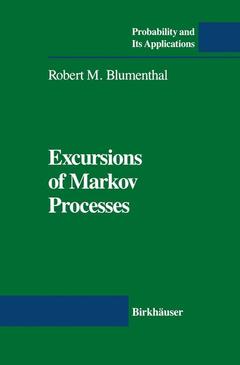Excursions of Markov Processes, Softcover reprint of the original 1st ed. 1992 Probability and Its Applications Series
Langue : Anglais
Auteur : Blumenthal Robert M.

Let {Xti t ~ O} be a Markov process in Rl, and break up the path X t into (random) component pieces consisting of the zero set ({ tlX = O}) and t the "excursions away from 0," that is pieces of path X. : T ::5 s ::5 t, with Xr- = X = 0, but X. 1= 0 for T < s < t. When one measures the time in t the zero set appropriately (in terms of the local time) the excursions acquire a measure theoretic structure practically identical to that of processes with stationary independent increments, except the values of the process are paths rather than real numbers. And there is a measure on path space that helps describe the measure theoretic properties of the excursions in the same way that the Levy measure describes the jumps of a process with independent increments. The entire circle of ideas is called excursion theory. There are many attractive things about the subject: it is an area where one can use to advantage general probabilistic potential theory to make quite specific calculations, it provides a natural setting for apply ing esoteric things like David Williams' path decomposition, it provides a method for constructing processes whose description in terms of an in finitesimal generator or some such analytic object would be complicated. And the ideas seem to be closely related to a good deal of current research in probability.
I Markov Processes.- 0. Introduction.- 1. Basic terminology.- 2. Stationary transition functions.- 3. Time homogeneous Markov processes.- 4. The strong Markov property.- 5. Hitting times.- 6. Standard processes.- 7. Killed and stopped processes.- 8. Canonical realizations.- 9. Potential operators and resolvents.- II Examples.- 1. Examples.- (a) Processes with stationary independent increments.- (b) Transformations.- (c) Diffusion processes.- (d) Special processes.- (e) Linking.- 2. Brownian motion.- (a) Existence.- (b) Conditional probabilities.- 3. Feller Brownian motions and related examples.- (a) Sawtooth processes.- (b) Local time.- (c) Feller Brownian motions.- III Point Processes of Excursions.- 1. Additive processes.- 2. Poisson point processes.- 3. Poisson point processes of excursions.- (a) Additive functionals.- (b) Excessive functions.- (c) Local time.- (d) Point processes of excursions.- (e) The characteristic measure.- (f) Markov properties of the excursion measure.- (g) The non-recurrent case.- IV Brownian Excursion.- 1. Brownian excursion.- 2. Path decomposition.- 3. The non-recurrent case.- 4. Feller Brownian motions.- 5. Reflecting Brownian motion.- V Itô’s Synthesis Theorem.- 1. Introduction.- 2. Construction.- (a) Approximating processes.- (b) Entrance laws.- (c) Resolvents.- (d) Markov processes.- 3. Examples and complements.- (a) Feller Brownian motions.- (b) Skew Brownian motion.- (c) Skew product diffusions.- 4. Existence and uniqueness.- 5. A counter-example.- 6. Integral representation.- VI Excursions and Local Time.- 1. Introduction.- 2. Ray’s local time theorem.- (a) Excursions and local time.- (b) Some local time formulas.- (c) Ray’s theorem.- 3. Trotter’s theorem.- (a) Occupation time density.- (b) Excursion local time.- (c) The excursion filtration.- 4. Super Brownian motion.- VII Excursions Away From a Set.- 1. Introduction.- 2. Additive functionals and Lévy systems.- (a) Potentials.- (b) Local time and time changes.- (c) Absolute continuity.- (d) Lévy systems.- 3. Exit systems.- (a) The kernel Pˆ.- (b) Markov properties.- (c) The excursion data.- 4. Motoo Theory.- (a) The boundary system.- (b) Feller Brownian motions in the upper half plane.- (c) Uniqueness.- (d) Additive functional formulas.- (e) Construction.- Notation Index.
Date de parution : 06-2012
Ouvrage de 276 p.
15.5x23.5 cm
Disponible chez l'éditeur (délai d'approvisionnement : 15 jours).
Prix indicatif 73,84 €
Ajouter au panierThème d’Excursions of Markov Processes :
Mots-clés :
Generator; Markov process; local time; path space; probability
© 2024 LAVOISIER S.A.S.



